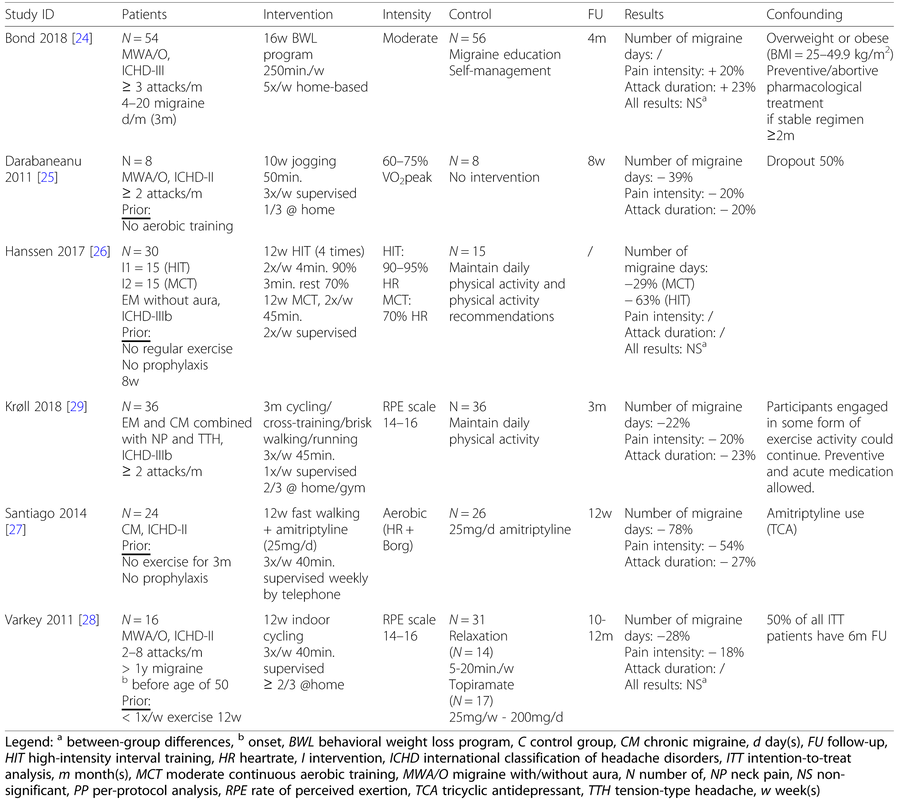Exercise
Aerobic exercise may be associated with a reduction in the number of migraine days, according to moderate-quality evidence from a systematic review and meta-analysis published in the Journal of Headache and Pain.
Lemmens J, De Pauw J, Van Soom T, Michiels S, Versijpt J, van Breda E, Castien R, De Hertogh W. The effect of aerobic exercise on the number of migraine days, duration and pain intensity in migraine: a systematic literature review and meta-analysis. J Headache Pain. 2019 Feb 14;20(1):16. doi: 10.1186/s10194-019-0961-8. PubMed PMID: 30764753.
Researchers searched the literature for studies in which individuals with migraine with or without aura were randomly assigned to engage or not in aerobic exercise ≥6 weeks. Studies included evaluated the number of migraine days, attack frequency, and pain intensity or duration of migraine attacks. Migraine was classified according to the International Classification of Headache Disorders (ICHD-II). A total of 6 randomized controlled studies were identified and included in the pooled analysis.
Exercise assessed in the studies included walking, jogging, a behavioral weight loss program, cycling, and a combination of cross-training, walking, jogging, and cycling. Based on headache diary reports from 4 studies, aerobic exercise was associated with a reduction in the number of migraine days at 10 to 12 weeks (mean reduction, 0.6±0.3 migraine days/month; P =.0006). Unpooled data from 3 studies indicated a reduction in migraine pain intensity of 20% to 54% and a decrease in attack duration of 20% to 27% after aerobic exercise.
The high percentage of women (88%) and the small number of studies included in the analysis represent 2 of the study’s limitations.
“Major gaps exist in the current knowledge on the effect of aerobic exercise on patients with migraine. Further research to study the effects reported in this systematic review are mandatory to unravel the mechanisms of physical training on migraine,” noted the study authors.
Lemmens J, De Pauw J, Van Soom T, Michiels S, Versijpt J, van Breda E, Castien R, De Hertogh W. The effect of aerobic exercise on the number of migraine days, duration and pain intensity in migraine: a systematic literature review and meta-analysis. J Headache Pain. 2019 Feb 14;20(1):16. doi: 10.1186/s10194-019-0961-8. PubMed PMID: 30764753.
Researchers searched the literature for studies in which individuals with migraine with or without aura were randomly assigned to engage or not in aerobic exercise ≥6 weeks. Studies included evaluated the number of migraine days, attack frequency, and pain intensity or duration of migraine attacks. Migraine was classified according to the International Classification of Headache Disorders (ICHD-II). A total of 6 randomized controlled studies were identified and included in the pooled analysis.
Exercise assessed in the studies included walking, jogging, a behavioral weight loss program, cycling, and a combination of cross-training, walking, jogging, and cycling. Based on headache diary reports from 4 studies, aerobic exercise was associated with a reduction in the number of migraine days at 10 to 12 weeks (mean reduction, 0.6±0.3 migraine days/month; P =.0006). Unpooled data from 3 studies indicated a reduction in migraine pain intensity of 20% to 54% and a decrease in attack duration of 20% to 27% after aerobic exercise.
The high percentage of women (88%) and the small number of studies included in the analysis represent 2 of the study’s limitations.
“Major gaps exist in the current knowledge on the effect of aerobic exercise on patients with migraine. Further research to study the effects reported in this systematic review are mandatory to unravel the mechanisms of physical training on migraine,” noted the study authors.
